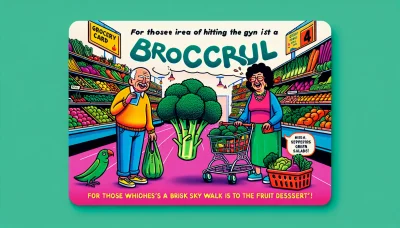High fiber foods low carb Quiz
Test Your Knowledge
Question of
Understanding High Fiber, Low Carb Diets
The Basics of High Fiber, Low Carb Eating
Diving into high fiber, low carb diets can be a game-changer for your health! These diets focus on reducing carbohydrate intake while emphasizing foods rich in fiber. The goal is to achieve a balance that supports bodily functions while managing weight and blood sugar levels. It's not just about cutting carbs; it's about choosing the right ones.
Fiber is a nutritional powerhouse, vital for digestive health and keeping you feeling full longer. But that's not all! It also plays a role in reducing cholesterol levels and regulating blood sugar. Ingesting adequate fiber can be a cornerstone of disease prevention, truly making it a superhero nutrient!
Impact of Low Carb Intake on Health
Low carb diets have taken the world by storm, and for good reason! They're linked to improved cardiovascular health and can be incredibly effective for weight loss. By slashing carbs, you encourage your body to burn fat for fuel, potentially turbocharging your metabolism. Picture your body as an efficient machine, with low carb intake fine-tuning its performance.
Beyond weight management, reducing carbohydrate consumption can lead to lower blood sugar levelsit's like hitting the reset button on your body's sugar management systems. For many, this means waving goodbye to those pesky energy crashes and hello to sustained vigor throughout the day!
Key Principles of a High Fiber, Low Carb Diet
To nail a high fiber, low carb diet, you need to understand macronutrients. Carbs are often demonized, but they're not all villainsfocus on complex carbs packed with fiber! Proteins and fats are also key players; they need to be balanced to create a symphony of nutrients that keep your body at peak performance.
Balancing Macronutrients
Imagine your plate as a canvas where you paint with proteins, fats, and carbohydrates. Achieving the perfect nutritional artwork requires balancing these macronutrients strategically. This balance helps sustain energy levels, maintain muscle mass, and optimize overall health.
Identifying High Fiber, Low Carb Foods
- Vegetables: Go green (and red and purple)! Vegetables like broccoli and bell peppers are jam-packed with nutrients without the carb overload.
- Fruits: Some fruits are surprisingly low in carbs yet high in fiberthink avocados and berries!
- Nuts & Seeds: Almonds and chia seeds are tiny but mighty sources of good fats and fiber.
- Legumes: Beans may come with more carbs but they're also loaded with fiber and proteina true nutritional trifecta.
- Whole Grains: Choose grains wisely; quinoa and oats offer low carb profiles with generous amounts of fiber.
Common Myths and Misconceptions
Debunking Carb Myths
All carbs are not created equal! There's a world of difference between refined sugars in cookies and complex carbs in sweet potatoes. The latter provides sustained energy without spiking your blood sugara clear win!
The myth that "carbs make you fat" is too simplistic. It's the type of carb that matters most. Refined carbs can contribute to weight gain because they're often found in calorie-dense foods lacking other nutrients. However, complex carbs can be part of a healthy weight management plan.
Clearing Up Fiber Fallacies
"Too much fiber is bad for you"this myth neglects the fact that most people don't even meet their daily recommended intake of fiber! While it's true that an excess might cause digestive discomfort initially, building up gradually can lead to impressive health benefits without any issues.
Fiber is sometimes mistakenly seen as just a tool for those struggling with constipation; however, its benefits extend far beyond the bathroom door! Regular fiber intake has been linked to reduced risk of chronic diseases like type 2 diabetes and cardiovascular diseasemaking it an unsung hero in our diet!
Essential Foods for High Fiber, Low Carb Diets
Vegetables: The Nutrient Powerhouses
Embarking on a high fiber, low carb diet? Vegetables are your best friends! Not only are they brimming with vitamins and minerals, but they're also low in carbs and high in fiber. This magical combination helps you feel full longer while supporting your digestive health and maintaining blood sugar levels. Dive into a world of colorful veggies, and watch your meals transform into vibrant plates of healthful delight!
Make no mistake: not all vegetables are created equal when it comes to carb content. To maximize your nutrient intake without the carb overload, prioritize non-starchy options like bell peppers, zucchini, and asparagus. These champions offer you the nutritional kick without the carb punch, making them essential players in your high fiber, low carb lineup.
Leafy Greens and Their Advantages
Leafy greens are simply phenomenal! Spinach, kale, and lettuce these are the titans of nutrition that pack a punch with very few carbs. They're teeming with antioxidants, vitamins A, C, E, K, and essential minerals like iron and calcium. Adding a generous portion of leafy greens to your meals ensures you're fueling your body with quality substances while keeping those pesky carbs at bay.
Here's a tip: Want to turbocharge your salads? Toss in some arugula or watercress for an extra peppery zing! These greens not only elevate the flavor profile but also contribute additional nutrients that make every bite count towards your health goals.
Cruciferous Vegetables for Balanced Meals
The cruciferous family think broccoli, cauliflower, and Brussels sprouts these are your heavy hitters in the vegetable world. They offer an impressive array of health benefits including fibers that support digestion and phytonutrients that may help fend off disease. And let's not forget their versatility; from roasting to steaming or even ricing them for a low-carb alternative to grains!
Did you know that these veggies can also help balance hormones? That's right! They contain compounds which have been suggested to aid in hormonal balance. So load up on cruciferous vegetables for a well-rounded diet that keeps your body functioning like a well-oiled machine.
Nuts and Seeds: Compact Nutrition Sources
Nuts and seeds are absolute game-changers for anyone on a high fiber, low carb path! They're densely packed with healthy fats, proteins, and yes fiber! These bite-sized powerhouses can help curb cravings and provide sustained energy throughout the day. Snack on them between meals or add them to dishes for a nutritious crunch that's both satisfying and beneficial.
Mix it up! Variety is key when it comes to nuts and seeds due to their diverse nutrient profiles. Almonds excel in vitamin E content while sunflower seeds bring magnesium to the table. By incorporating different types into your diet, you ensure a broader range of vitamins and minerals.
Almonds, Chia Seeds, and Flaxseeds
Almonds are more than just tasty; they're incredibly nutritious too! A handful offers protein, healthy fats, and fiber while keeping carbs minimal. Chia seeds are another standout; they can absorb several times their weight in water which helps create a feeling of fullness. And let's not overlook flaxseeds - these little gems boast omega-3 fatty acids which are great for heart health.
Fiber-rich chia seeds have a unique property when soaked in liquid they form a gel-like substance. This trait makes them perfect for creating puddings or thickening smoothies while boosting their fiber content significantly!
How to Incorporate Nuts and Seeds into Your Diet
- Add chia or flaxseeds to smoothies for an instant nutrient boost.
- Sprinkle chopped nuts over salads or yogurt to enhance texture and taste.
- Use almond flour instead of traditional flour for baking healthier treats.
- Create homemade trail mix with various nuts and seeds for on-the-go snacking.
- Incorporate nut butters into sauces or dressings for added richness.
- Toast seeds like pumpkin or sunflower as a crispy topping for soups.
- Pack nut-based energy balls as portable snacks filled with protein and fiber.
- Blend nuts into plant-based milk alternatives rich in nutrients.
Protein-Rich Foods with Fiber
Finding protein-rich foods that are also high in fiber yet low in carbs might seem like searching for a needle in a haystack but it's entirely possible! These foods support muscle maintenance while aiding digestion without the extra carbohydrates bogging down your dietary efforts. It's about making smart choices that align with your dietary goals while ensuring complete nutrition.
Selecting protein sources can be strategic opt for those that provide added benefits such as fiber or healthy fats. This approach helps streamline your diet by packing more nutritional value into each meal or snack you consume.
Plant-Based Proteins
If you're leaning towards plant-based proteins fantastic choice! Legumes like lentils and black beans come packed with both protein and fiber while keeping carbs relatively low. Tofu is another brilliant option; it's versatile enough to take on any flavor profile while contributing valuable nutrients essential for bodily functions.
Tempted by tempeh? You should be! This fermented soy product is not only rich in protein but also brings probiotics into the mix which can support gut health. Its one of those superfoods that checks multiple boxes for those following high fiber, low carb diets!
Animal-Based Low Carb Options
Carnivores fear not; there are plenty of animal-based proteins suitable for a high fiber diet too! Lean meats like chicken breast or turkey offer ample protein without unnecessary carbs. Fish such as salmon provide omega-3 fatty acids along with protein ideal if youre striving for heart health alongside weight management!
Eggs are another nutritional powerhouse containing high-quality protein along with choline which is vital for brain health. And remember shellfish? Shrimp packs a protein punch without adding carbs to your plate making it another excellent choice within the realm of animal proteins!
Planning Your High Fiber, Low Carb Meals
Breakfast Ideas to Kickstart Your Day
Starting your day with a high fiber, low carb breakfast can fuel your morning while keeping you on track with your health goals. Opt for nutrient-dense foods that offer a balance of healthy fats, proteins, and fibers to maintain energy levels without the carb crash.
Incorporate high-fiber foods like chia seeds or flaxseeds into your morning routine. They're easy to add to smoothies or yogurt and can significantly boost your daily fiber intake. Remember, a breakfast rich in fiber promotes satiety and aids in digestion.
Quick and Easy Recipes
Eggs are a fantastic low-carb option that pairs wonderfully with fiber-rich vegetables like spinach or kale. Try an omelet or a frittata loaded with veggies for a quick meal. Alternatively, blend up a green smoothie with avocado, spinach, and protein powder for an on-the-go boost.
A bowl of high-fiber cereal with almond milk is another quick fix for busy mornings. Look for brands that use nuts and seeds as their base to keep the carbs down and the satisfaction up.
Make-Ahead Options for Busy Mornings
Meal prepping isnt just for lunches and dinnersbreakfast can be prepped ahead too! Bake a batch of low-carb muffins using almond flour or whip up some chia seed pudding and refrigerate overnight. These make-ahead options ensure you have no excuse to skip out on a hearty breakfast.
Overnight oats made with unsweetened coconut milk, chia seeds, and a touch of stevia can be a lifesaver for those who need to grab-and-go. Top them with nuts or berries in the morning for extra flavor and fiber.
Satisfying Lunches That Keep You Full
Lunches should be satisfying enough to prevent mid-afternoon slumps while aligning with your dietary goals. A high fiber, low carb lunch can provide sustained energy levels without the heaviness associated with high-carb meals.
Balance is crucial; ensure your lunch has adequate protein along with fiber-rich vegetables. This combination helps manage blood sugar levels and keeps you feeling full longer.
Salads with a Twist
Gone are the days of boring salads! Amp up the flavor by adding roasted nuts, seeds, or even cheese like feta or goat cheese for added richness. Use dark leafy greens such as kale or arugula as a basethey're packed with nutrients and have minimal carbs.
- Mix in grilled chicken or tofu for protein.
- Drizzle olive oil-based dressings for healthy fats.
- Add avocados or olives for texture and extra fiber.
- Sprinkle chia seeds or crushed walnuts for crunch.
- Include berries or pomegranate seeds for natural sweetness.
Hearty Soups and Stews
Soups and stews can be excellent vessels for both fiber and flavor without excess carbs. Utilize broth-based recipes filled with non-starchy vegetables like broccoli, zucchini, and mushrooms. These ingredients bulk up your meal without bulking up the carb count.
Lentil or black bean soups are also great optionsjust watch the portion size to keep carbs in check. They're rich in protein and fiber which aid in digestion while adding heartiness to your meal that will keep you satisfied until dinner time rolls around.
Dinner Delights Without the Carbs
Dinner is the perfect time to get creative with high fiber vegetables that take the place of traditional carbohydrate-heavy sides. Experimenting with different cooking methods like roasting, sauting, or grilling can bring out unique flavors from these healthful ingredients.
Main Courses with High Fiber Veggies
Create main courses that highlight vegetables such as spaghetti squash or zucchini noodles instead of pasta. These veggie alternatives pair beautifully with robust sauces while keeping carbs minimal. A sprinkle of cheese adds richness without compromising on healthfulness.
Cauliflower is another versatile vegetable that can be transformed into anything from pizza crusts to rice dishes. Pair it with lean meats like chicken breast or fish fillets seasoned well to keep dinner interesting yet nutritious.
Creative Side Dishes to Complement Your Meal
Sides don't have to be an afterthought; they can steal the show! Think outside the box by making mashed turnips instead of potatoes or serving roasted brussels sprouts topped with balsamic glaze. These sides are not only delicious but also rich in fibers and nutrients while being low in carbs.
An array of colorful roasted vegetables seasoned with herbs makes an eye-catching side dish that's bursting with both flavor and nutrition. Include choices like bell peppers, eggplant, and cherry tomatoestheir natural sweetness intensifies when roasted!
Snacking on a High Fiber, Low Carb Diet
Smart Snacking Strategies
Embarking on a high fiber, low carb diet doesn't mean you have to bid farewell to snacking. In fact, smart snacking can propel you towards your health goals! It's all about choosing the right snacks that align with your dietary needs while keeping you satiated. Opt for foods that are both nourishing and delicious, ensuring you don't feel deprived.
Portion Control Tips: Keep your snacks in check with portion control. Use small plates or bags to pre-portion your snacks; this prevents overeating and helps maintain a calorie deficit if weight loss is your aim. Remember, even healthy snacks can contribute to weight gain when consumed in large quantities.
Timing Your Snacks for Optimal Energy: Timing is everything! Snack when you actually need an energy boost, typically mid-morning or mid-afternoon. This helps keep blood sugar levels stable and prevents overeating at meal times. Listen to your body's hunger cues and fuel it accordingly with high-quality snacks.
On-the-Go Snack Ideas
Staying true to your diet while out and about is crucial for success. This means being prepared with portable snack options that wont derail your efforts. Choose snacks that are convenient yet packed with nutrients to keep you feeling full and energized until your next meal.
Portable High Fiber Choices: High fiber snacks are great for digestion and keeping you full longer. Think almonds, chia seed pudding, or a small serving of berries. These options are not only packed with fiber but also easy to carry wherever you go.
Low Carb Snacks That Satisfy Cravings: To satisfy those cravings without the carbs, turn to cheese slices, hard-boiled eggs, or slices of turkey breast. Theyre protein-rich, making them excellent for staving off hunger until your next meal.
Homemade Snack Recipes
Making snacks at home can be a game-changer for anyone following a high fiber, low carb diet. Homemade snacks give you full control over the ingredients, ensuring they fit within your dietary parameters without any hidden sugars or carbs.
- Easy-to-Make Energy Balls: Combine nuts, seeds, and a bit of unsweetened coconut in a food processor; roll into balls for a quick snack loaded with healthy fats and fiber.
- Baked Veggie Chips for Crunchy Cravings: Slice up zucchini or kale, toss with olive oil and seasonings, then bake until crispy. You'll get that satisfying crunch without the carbs found in traditional chips.
Overcoming Challenges in High Fiber, Low Carb Diets
Dealing with Social Situations and Dining Out
Navigating social gatherings while sticking to a high fiber, low carb diet can be a test of willpower. But fear not! With the right strategies, you can enjoy dining out without derailing your dietary goals. It's all about making informed choices and planning ahead!
When attending events or eating at someone's home, communicate your dietary preferences beforehand. Offer to bring a dish that fits your diet so you have a safe option. Remember, your health journey is yours to own, and there's no shame in sticking to it amidst social settings.
Restaurant Choices and Tips
Eating out doesn't have to be a daunting experience. Many restaurants now offer customizable dishes that cater to various dietary needs. Look for menu items rich in vegetables and lean proteins, and don't hesitate to ask how the food is prepared or for substitutions.
- Choose grilled over fried options.
- Ask for dressings and sauces on the side.
- Opt for dishes with non-starchy vegetables as the base.
- Select water or unsweetened beverages instead of sugary drinks.
- Inquire about whole-food, high-fiber options like salads and veggie platters.
Handling Social Pressure Gracefully
Social pressure can be one of the trickiest parts of maintaining your diet. Be assertive yet polite when declining foods that don't align with your dietary choices. You can explain your health commitments without being confrontational or apologeticafter all, true friends will support your healthy decisions!
Avoid making others feel uncomfortable about their food choices as well. By keeping the focus on your personal health goals rather than judging different diets, you'll maintain harmony and might even inspire someone else to make healthier choices.
Managing Cravings and Hunger Pangs
The longing for carbs can strike hard, but there are powerful ways to keep those cravings at bay! Staying adequately hydrated, getting enough sleep, and managing stress levels are pivotal in reducing the urge to reach for high-carb snacks.
Mindful Eating Techniques
Mindful eating is a phenomenal tool that can help manage cravings by encouraging a deeper connection with your food. Take time to savor each bite and listen to your body's hunger signals. It's not just about what you eat; it's also about how you eatslowly, deliberately, and with intention.
Satiating Foods That Curb Hunger
To quell hunger pangs, stock up on foods that are both satisfying and aligned with your low carb goals. Foods high in fiber like avocados, nuts, and seeds not only fill you up but also provide essential nutrients. Lean proteins are also excellent for satiationthink chicken breast, tofu, or fish.
Adapting Recipes for Dietary Restrictions
Cooking at home is a fantastic way to control what goes into your meals. Don't let dietary restrictions stifle your culinary creativity; many recipes can be modified to fit a high fiber, low carb lifestyle. Experimenting in the kitchen can lead to delicious discoveries!
Gluten-Free and Dairy-Free Options
Finding alternatives for gluten and dairy is easier than ever before. Almond flour or coconut flour can replace traditional wheat flours, while nut milks and coconut cream offer creamy textures without dairy. Embrace these substitutesthey might just become new favorites!
Vegan and Vegetarian Swaps
If you're vegan or vegetarian on top of following a high fiber, low carb diet, fear not! Plant-based proteins like lentils and chickpeas are great alternatives to meat-based dishes. Plus, tempeh and seitan are fantastic for adding texture and bulk up meals without compromising on carbs.
Tracking Progress and Making Adjustments
Setting Realistic Goals and Expectations
Embarking on a dietary journey is thrilling, but it's crucial to anchor your enthusiasm in reality. Setting realistic goals is the cornerstone of any successful diet plan. It's about understanding your body's needs and creating achievable targets that spur you on without leading to disappointment. Remember, this is a marathon, not a sprint!
It's all about balance! Short-term milestones are your secret weapon for maintaining motivation. They provide quick wins that keep your spirits high and give you tangible proof of progress. Whether it's shedding a few pounds or successfully resisting temptation, celebrate these victories they're stepping stones to your ultimate success.
Now, let's talk about the horizon long-term goals are the lighthouses guiding you through your health odyssey. They represent the bigger picture of what you're striving for, be it significant weight loss, muscle gain, or improved overall health. These goals keep you grounded and focused on the endgame while navigating through life's dietary storms.
Monitoring Your Dietary Intake
What gets measured gets managed! Monitoring what you eat is pivotal in any diet strategy. Keeping a food journal or using tracking apps can be game-changing by providing insights into your eating habits. Its like having a personal diet detective that helps pinpoint areas for improvement.
- Food Journals: A simple yet powerful tool to visually account for your daily intake.
- Tracking Apps: Technology at its finest, offering convenience and detailed analysis of your nutritional habits.
- Nutritional Labels: An essential read for anyone serious about their diet. They unravel the mystery behind whats really in your food.
- Mindful Eating: Its not just about what you eat, but how you eat. Slow down and savor every bite for better digestion and satisfaction.
Diving deeper into nutritional labels unveils the truth behind food marketing. Understanding these labels empowers you to make informed choices that align with your dietary goals. Its like having a secret codebook to navigate the complex world of food ingredients knowledge is power!
Tweaking Your Diet for Better Results
Sometimes even well-laid plans need adjusting don't be afraid to tweak your diet for optimal results. If you hit a plateau or feel sluggish, reassessing fiber intake could be key. Gradually increasing fiber can boost digestion and keep you feeling fuller longer without derailing your efforts.
Your energy levels are crucial indicators of how well your diet is serving you. If you find yourself dragging through the day, it might be time to adjust carb levels. Carbs aren't the enemy; they're fuel for your body! Tailoring carb intake to match energy demands ensures you have the vim and vigor to conquer your day!
The Role of Exercise in a High Fiber, Low Carb Lifestyle
Integrating Physical Activity with Your Diet Plan
Adopting a high fiber, low carb diet is a powerful step towards better health, and coupling it with regular exercise can amplify the benefits. Exercise not only helps burn calories but also regulates appetite and improves insulin sensitivity. It's a match made in heaven for those aiming to manage their weight effectively.
When integrating physical activity into your diet plan, consistency is key. Aim to incorporate at least 150 minutes of moderate aerobic activity or 75 minutes of vigorous activity per week, as recommended by health authorities. Remember, every bit counts, so even short bursts of activity can add up throughout the day.
Best Exercises for Weight Management
For weight management, a combination of cardio and strength training is unbeatable. Cardio exercises like running, cycling, and swimming are fantastic for burning calories and improving cardiovascular health. On the other hand, strength training builds muscle mass which boosts your metabolism long-term meaning you'll burn more calories even at rest!
Creating a Balanced Workout Routine
A balanced workout routine should include variety to keep things interesting and work different muscle groups. Incorporate flexibility exercises such as yoga or Pilates to improve range of motion and reduce injury risk. Always listen to your body and allow adequate rest days for recovery to prevent burnout and overtraining.
Benefits of Exercise for Digestive Health
Exercise does more than just shape your physique; it's also crucial for maintaining digestive health. Regular physical activity stimulates the intestines and can help keep you regular. This natural boost to your digestive system complements the benefits gained from a high-fiber diet.
How Movement Aids Digestion
Movement is like an internal massage for your digestive tract. It increases blood flow and helps food travel through the digestive system more efficiently. This can alleviate symptoms like bloating and constipation, which are common issues when adapting to a high fiber diet.
Exercises to Enhance Gut Function
Certain exercises can be especially beneficial for gut function. Low-impact activities such as walking or cycling are excellent at promoting bowel movements without straining the body. Core workouts strengthen abdominal muscles, supporting the intestines and improving overall digestive efficiency.
Staying Motivated and Consistent
Finding motivation for regular exercise while adjusting to dietary changes can be challenging but is essential for long-term success. To stay motivated, choose activities you enjoy whether it's dancing, hiking, or playing a sport so that exercise feels less like a chore and more like a rewarding part of your lifestyle.
Setting Achievable Fitness Goals
- *Start with clear, realistic goals based on your current fitness level. *Break down larger goals into smaller milestones to celebrate progress along the way. *Incorporate variety in your workouts to keep them engaging and reduce boredom. *Consider working with a fitness professional initially to create a tailored plan that aligns with your dietary choices. *Use fitness apps or journals to track your progress and stay accountable. *Remember that setbacks are normal; what matters is getting back on track quickly. *Reward yourself for meeting goalsbut not with foodto reinforce positive behavior. *Stay patient; meaningful changes take time, dedication, and consistent effort.
Tracking Fitness Progress Alongside Dietary Changes
To truly gauge how well you're doing, track both fitness progress and dietary changes together. Use tools like apps or journals to log workouts as well as meals. This holistic approach provides valuable insights into how diet and exercise influence each otherand ultimately your health outcomes.












